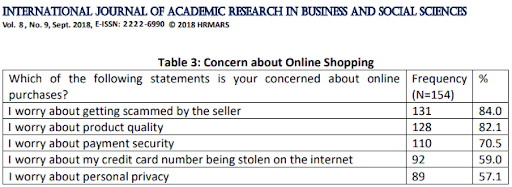7 Actionable Ways to Build Trust In an E-commerce website
Trust is a huge part of E-commerce.
When people visit a new online store, they can be hesitant to make a purchase. People are more likely to purchase from websites that they feel confident in and trust.
If you want to convert shoppers into customers, you need to build trust with your visitors and increase their confidence in your brand as well as site. Here are 7 key ways to build trust in an E-commerce website.
1. Show that your website is trustworthy
Many consumers fail to trust E-commerce stores because they are concerned that the products they purchase online may not be genuine or of good quality.

Research showing various customer concerns about online purchases.
Image by Human Resource Management Academic Research Society
As it is difficult for consumers to judge the quality of products online, it is therefore paramount that an E-commerce business fosters trust amongst their consumers and puts them at ease to make purchases with confidence. Here are some sure-fire ways to do this.
Display visual indicators of trust
What are indicators of trust?
A visual indicator of trust is an icon, logo or text that a customer can look at to immediately assess the trustworthiness of the E-commerce site they are on. A good visual indicator of trust would put customers at ease and build credibility for the site.
For an E-commerce store, you can use visual trust indicators such as badges or accreditations from third-party companies or associations.
For example, you can get a Trust Seal from Trust Guard, which shows visitors that the store is scanned and validated regularly for website security vulnerabilities.

Image by Trust Guard
This helps to show your customers that your website is safe and secure.
Highlight your media mentions
If you are a business owner, you may have your products mentioned in the media. Highlighting how often your brand or products have been mentioned in the media can help reassure customers that they are buying from a legitimate business.
You might have seen these ‘As featured on’ segments on company websites. Like newspapers or article clippings seen at food stalls, media mentions are the digital versions that can reassure customers that they are purchasing from a reliable business.

Image by Joytingle
Use human photos
One way to build trust in an E-commerce store is to use human photos on your website, as opposed to stock photos or cartoons. According to a study by Olapic, 32% of customers are more likely to buy clothing online if a website shows photos of real customers wearing the item.
If you show reviews or testimonials on your website, it will be extremely beneficial if you also display a photo of the person using the item that they bought.

Image from Amazon
Share your brand’s story
Storytelling is a poignant marketing tool that can help retailers connect with customers. A brand story goes beyond product descriptions or website design; it represents the purpose and values of your company.
When potential customers see how passionate and genuine the business owner is, they are more likely to trust that the store will be reliable. A brand’s story can also highlight how different a company is from its competitors. It can also showcase how well the company has been performing over time.
2. Live up to your customers’ product expectations
Your product images should highlight actual features of the products. Go the extra mile by providing videos to explain product specifications and how they can be used. This will help them to better understand your product, what it can and cannot do, and decide whether it is a good fit for their needs.
Your product images should also represent reality. For example, while it may be challenging to portray the true colour of your product in images, you can try to reduce customers’ uncertainty by providing product images in different types of lighting.
ASOS does this well by featuring a 15-second video for each piece of clothing. The video shows a model wearing the clothing and moving around so shoppers can better visualise how the clothing will be like when worn.

Image by ASOS
Avoid the stock-shot look
While it might seem like a good idea to try and save money by using product stock photos, it might actually work against you. This is because 67% of consumers say that the quality of a product image is “very important” in their selection and purchasing decision.
For an E-commerce store, having unique photographs taken professionally will give you more control over the product images you want to showcase. Distinctive product photos styled and taken according to your store’s branding guidelines will also help strengthen your image and reputation.
3. Provide all the information your customers need
Make it easy for your potential customers to find all the information they need in your E-commerce website. Be transparent and clear with information like your store’s shipping and return policies. Make these pieces of information easily accessible and don’t hide them in the final step of the checkout process.
Likewise, make sure other information like ‘About Us’ and your contact details can be found with no effort. This way, customers can easily reach out to you if they have any concerns or questions.
It is also helpful to have a ‘Frequently Asked Questions (FAQ)’ section on your E-commerce website to address questions that you find your customers asking repeatedly. This allows you to address questions that you have already answered often and avoid having to answer them again.
For example, you can provide your E-commerce store’s delivery lead time for an order. If you have this question covered in your FAQ page, potential customers will be able to find out and see if they are comfortable with your store’s delivery lead time before placing an order, and will not need to contact your store’s support team.
4. Provide prompt and excellent customer support
According to the PwC Future of Customer Experience Survey 2017/18, one-third of those surveyed said they would stop doing business with a brand they loved after just one negative experience.
The same survey also found that customer experience was the third most important factor when it came to their purchasing decisions (after price and product quality).
Hence, it cannot be denied that providing prompt and excellent support can help you build your online store’s reputation as well as its level of trust among potential customers. Here are some actionable ways you can do this.
Provide customer support through multiple channels
Make it easy for customers to reach out. They might want to contact you through various avenues such as email, phone call, live chat, or social media channels like Facebook and Twitter.
Include all this contact information in the ‘Contact Us’ section of your website.
Train your customer support team
Build a customer service team that is knowledgeable and helpful. For instance, keep them regularly updated on the specifications of your new products so that they are equipped with the knowledge to answer your customers’ questions.
Furthermore, ensure that your customer support representatives are prompt in their replies and provide accurate information. One way to do this is by setting up a customer timeline that highlights how long it should take for your team members to reply. This will help you monitor how timely and helpful your team is in their responses.
Offer after-sales reassurance
Provide after-sales reassurances such as sending your customers a confirmation email, an order tracking ID, and SMS alerts when you have shipped the package. It will make your customers feel confident that their purchases are in good hands after doing business with your E-commerce store.
For example, if a customer is not sure how to track their order, provide them with instructions on how to do so or give them an option of receiving text message updates about their order.
Support and engage with your customers on social media
A great way to build trust in an E-commerce store is by engaging with customers on social media. As consumers are highly active on social media nowadays, it has become an important channel to respond to customer queries or complaints in a prompt and professional manner.
Brands that are successful on social media know how to do social media listening and engage their followers. This includes answering questions, sharing content, and participating in conversations.
When potential customers see that you are consistently there to listen to your audience and provide good customer service on social media, it will increase the level of trust they have in your E-commerce business.
5. Showcase your reviews
93% of consumers say that online customer reviews influence their purchasing decision. Show that your customers love your business by displaying your reviews.
Reviews show that customers have had a good experience with you and help reinforce that people trust your store. All in all, having good reviews will solidify your brand image.
Handle negative reviews appropriately
Reviews can be positive or negative. Although negative reviews are not a good thing, there are ways to turn them into something positive and constructive.
If you are faced with a negative review, don’t ignore the review by doing nothing about it. Take the time to respond quickly and explain how you will fix the issue and prevent it from happening again in the future. Be open and honest with your customers.
If you have already taken care of the problem, mention it in your response so that others can see that you have resolved the issue in a timely manner.
6. Pay attention to your E-commerce website design and user experience (UX)
An aesthetically pleasing website can go a long way in earning the trust of target customers. According to a study by Adobe, 65% of people surveyed want content to display well on the device they are using. 54% want the layout and images to be well designed.
Another interesting statistic showed that 38% of people will stop engaging with a website if the content/layout is unattractive, and 48% of people cited a website’s design as the number one factor in deciding the credibility of a business.
UX is also important for an E-commerce website. When visitors can navigate through your website easily, they’ll be more likely to find what they want and consequently make a purchase. Therefore, don’t underestimate the importance of E-commerce customer experience.
7. Protect your customers’ data and privacy
With data theft becoming increasingly prevalent nowadays, it is important to ensure that the data you collect from your customers is secure. You can do this by putting in place a company policy and security safeguards on how sensitive customer information should be handled with care (e.g. how it should not be accessed or who can access it).
One way of ensuring customer privacy is through Secure Sockets Layer (SSL) encryption which ensures all private communication taken up by your website stays encrypted, preventing anyone who might intercept these messages from being able to read them.
Conclusion
Building trust is important for the success of your E-commerce website. Whether you are a new start-up or have been around for decades, trust is critical to how customers will feel about making purchases from you online. Go ahead and implement the 7 actionable tips mentioned in this article and measure the results for yourself.